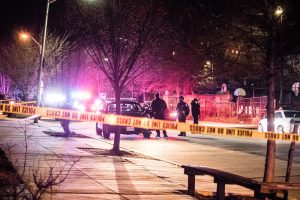Does the name Paul David Savanuck ring a bell?
It should. It’s a name that, in my humble opinion, every Jewish Baltimorean should know. In fact, I’d contend that the name should be etched onto a wall or plaque somewhere at the Baltimore Jewish Hall of Fame. (Hint, hint.)
Perhaps you’ve seen the name when reading a publicity item about the Paul D. Savanuck/B’nai Jacob-Shaarei Zion Memorial Post 888 of the Jewish War Veterans of the USA. Or if you’ve ever worked at or visited Fort Meade, maybe you noticed the Staff Sgt. Paul D. Savanuck Memorial Library located at the Defense Information School, which is where the Department of Defense trains military journalists, broadcasters and public affairs specialists.
Over the years, I’ve written about Savanuck’s life and legacy on numerous occasions, and he has served as an inspiration to me and others as a model journalist. Today, April 18th, marks the 50th anniversary of his death while serving in Vietnam and working for Pacific Stars and Stripes as a photojournalist.
A Baltimore native and 1963 graduate of the BaltimorePolytechnic Institute, Savanuck was, by all accounts, a thoughtful, determinedand restless young Jewish man who was studying for a bachelor’s degree injournalism at the University of Maryland in 1967. Simply put, he was madly inlove with the written word and determined to hone his craft as a journalist.
“Paul was caring, Paul was kind, Paul wastrustworthy,” recalled longtime friend Jack Cohen, who in 1971 was one of thefounders of the JWV post bearing Savanuck’s name.
Back in ’67, the war in Indochina was heating up, aswas the anti-Vietnam movement in the streets of America. The news here andabroad was bleak and disturbing. But Savanuck knew that he had to be where the action was. So he enlisted in the U.S. Army beforegraduating from College Park and studied at the Defense Information School,then located at Fort Benjamin Harrison in Indianapolis.
“I wasn’t particularly enchanted with the U.S. involvement in Vietnam and especially the idea of going there,” wrote Savanuck, who grew up in Pikesville. “[Still] I asked for assignment to Vietnam. … A thought had hit me — this was a point in my life where I could meet something head-on instead of avoiding it.”
Savanuck was originally assigned to a rather sleepy missile base in Mainz, Germany, but he initiated a letter-writing campaign to legislators such as the late Sen. Daniel Brewster (D-Md.) to be transferred to Vietnam. (How’s that for chutzpah?) He wanted to learn the fundamentals of combat reporting, and his courage and confidence appeared to be beyond boundaries.

Six months later, Savanuck was assigned to a unit in Vietnam, serving as a field correspondent, publicist and photographer for the information office of the 23rd Artillery Group at Phu Loi. He became section chief and covered events and happenings around what was then known as South Vietnam.
‘His Terrible Destiny’
A few months later, he began campaigning for a job with Pacific Stars and Stripes’ Saigon bureau. There was no opening there at the time, but Savanuck was relentless and kept coming back. He eventually snagged a job and began writing and photographing stories around Tay Ninh Province.
“I shall not be contentwith anything less than what is true,” Savanuck wrote. “I intend tobe the best.”
Savanuck’s long-range plan was to attend Harvard after being discharged from the Army. “I have found what I want to do,” he wrote in an admissions letter to the university.
But on April 18, 1969, while heading north with a 5th Division Armored Unit to cover a story, Savanuck was gunned down by North Vietnamese soldiers less than a mile from the Demilitarized Zone, north of the Cam Lo Valley. He died while reportedly trying to save a wounded infantryman. He was one of 11 American soldiers killed and 23 wounded that evening and morning when their encampment was overrun by the enemy.
Savanuckwas only 23 and had been working at PacificStars and Stripes for a mere 13 days.
“Paul Savanuck chose to engage his terrible destiny,” Stars and Stripes eulogized in an obituary. “His articles and touching photographs of the agony of victims, both American and Vietnamese and especially the children of this indefensible war, were widely used by national and international news services and periodicals.
“His letters home warily set forth his position on the war, but about his work, there was no question. … He loved what he was doing.”

Savanuck was the only Stars and Stripes correspondent killed during the Vietnam conflict (and the first since the Korean War). He was posthumously promoted to staff sergeant and awarded the Purple Heart, the Bronze Star and the Air Medal. The Defense Department also named its military print journalist of the year award after Savanuck.
‘A Soldier and a Journalist’
I was just a kid when the Vietnam War was raging, and I still recall writing and sending letters of support to American POWs over there as a fourth grade student at Powhatan Elementary School. It felt like the least we could do.
When I worked at Fort Meade a few years ago, I wrote a story for Soundoff!, the military installation’s weekly publication, about the Savanuck Library and interviewed its chief librarian, Mary Hickey. She said her staff and the school’s leadership took tremendous pride in the library’s namesake.
“He was a soldier and a journalist,” Hickey said.“Every once in a while, students will write a story about him and come in hereto do research.”
The library, which was named in Savanuck’s memory in 2003, maintains exhibition cases featuring Savanuck’s photos and letters, as well as his field camera and eyeglasses. It’s a fitting physical reminder of his contributions and commitment to the field of combat journalism.
Savanuck is buried in Baltimore Hebrew Congregation’s cemetery in Reisterstown, near the final resting place of his mother, Isabel (whom I once had the honor of interviewing). You can also find his name on wall panel 26, line 2 of the Vietnam Veterans Memorial in Washington, D.C. , as well as on the Maryland Vietnam Veterans Memorial at the foot of the Hanover Street Bridge in South Baltimore.
On the Virtual Vietnam Veterans Memorial Wall (virtualwall.org), an Army buddy ofSavanuck’s named Richard Kaplan shared, “He took some great pictures of me standing infront of my jeep that I have framed and hung in the family room of our homehere on Long Island. …. Paul and I were the only two Jewish guys on the entirebase. I remember flying down to Saigon with Paul on various occasions to visitan orphanage there. What a great guy he was. I only had three days to go inVietnam when I was notified of his death. What a total shock.”
Next month on Memorial Day, we traditionally remember and pay tribute to those who fell in the line of duty to our nation. But I’d ask that today, on the 50th anniversary of his death, please take a moment or two to honor the memory of Paul D. Savanuck, his place in Jewish Baltimore history, and his sacrifice to our country and his craft.
May his memory always be a blessing.





